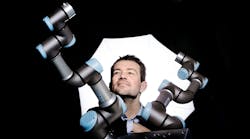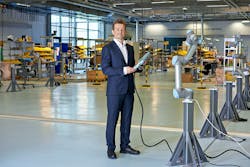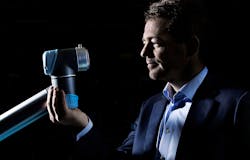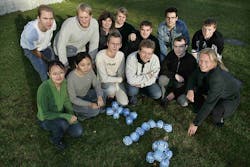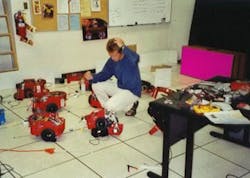Cobot Inventor on the Value of Humans in Factory, Robots in the Home
If you’re not crazy about the thought of robots taking all the jobs, then you should hold an Elon Musk-level of obsessive adoration for Danish roboticist Esben Østergaard. The co-founder and CTO of Universal Robots was the driving force behind the development of collaborative robots, or cobots. Østergaard designed these methodical, sensitive, force-limited arms, starting with the UR5 in 2008, to safely work alongside humans to help with work, not take it away.
More recently he has developed an intuitive interface so pretty much anyone in the factory can control these cobots, demolishing the knowledge barriers to adoption much like he ripped down the perpetual need for industrial robots to be stashed behind a safety fence.
For his efforts, Universal has become the cobot market leader, with a 58% share. More recently, at Automatica 2018, where UR debuted the new e-series, Østergaard was awarded the Engelberger Robotics Award in the technology category, named after the Father of Industrial Robots, Unimate creator Joseph F. Engelberger.
“His work in the field of collaborative robot applications has allowed robots to enter previously unthinkable sectors in just about every industry,” says Jeff Burnstein, president of the award granter Robotic Industries Association. “Esben Østergaard’s emphasis on robots that work side-by-side with people and are easy to use has created enormous interest among many small and medium sized companies who never even considered robots before. In a world that is increasingly characterized by people and robots working together, Esben’s pioneering technology advances play a pivotal role.”
The prestigious award, considered the highest in the field of robotics, has been given out since 1977. We recently spoke with the 44-year-old roboticist, the youngest ever to receive the award (though not the first Dane), about the work he’s done to earn to the honor, as well as what he thinks lies ahead for manufacturing and society when it comes to collaborating with robots.
John Hitch: How do you feel about winning this award?
Esben Østergaard: Of course it’s great and a lifetime achievement. Somehow, I think I’m too young for this. But I promise to do more. I’m not done yet.
JH: Which of your contributions to robotics are you most proud?
EO: I’m most proud of being a part of changing industrial robots from being these big things that were only for experts, and doing the same thing over and over again, to being used by engineers and factory floor workers and technical workers.
JH: There seems to be a shift from wanting lights out operations done only by robots to engineering production to be done by humans working alongside robots. When do you think that happened?
EO: It’s a recent thing. The paradigm was lights out, high volume, high throughput. There’s still room for those, but every factory isn’t going to be lights out. What we did with collaborative robots paved the way for this other kind of thinking. We have to consider the human value and safety, the craftsmanship and the understanding of the consumers, the materials and processes. Those are core parts of the factory’s value creation. It’s not just robots that create this value, but human working with machines to create more value.
JH: I read that you are big into philosophy. What’s your philosophy for guiding the technology at Universal Robots?
EO: We want to help people do their work more efficiently, because I think people want to work. We want to do something with our lives. We were not born lazy. If humanity was lazy at its core, we would have gone down to one-day work weeks after the first industrial revolution.
Our company philosophy is to enable that, to empower people. That’s why we made robots that are not supposed to replace people, but empower them to do more with their time and energy. A guy who has stood up at a CNC machine for the last 10 to 15 years, he should not be replaced by a robot. If the factory manager decides to do that, he’s clearing away something super valuable for the company. Typically, that guy knows the processes very well, he knows the materials very well, and the machine very well. He may not be highly educated, but he is a kind of expert. And a core part of the business. Instead of replacing him, we give him a tool to replace the boring part of his work. The robot can feed the machine and that will give it higher uptime and the person can become more of an expert, and take new orders for customers and optimize products.
JH: When did you realize that making robots easier to program was the missing ingredient?
EO: That’s the whole basis for the company. We did various research projects in my group [at the University of Southern Denmark]. For one of the projects—in the early 2000s—the Danish government posed the question: “What does it take to get more robots in the Danish food industry?”
We went out and identified two small fast food manufacturing companies. One made cakes the other made microwave food. They basically wanted to change their production line once a week or once a month to make a new kind of food depending on the season. For them it was not possible with the traditional robots to achieve that level of flexibility. Their rate of change was not high enough to have an entire department for robot automation. On the other hand, they were annoyed to call a system integrator every time they had to make adjustments. There was a time delay and a price. Their need for flexibility was not met with existing technology.
They tried to get some of these people with the paper hats to program the robots. And it was not possible. That’s where we got this idea that we should try to do it differently, making a machine they could understand and program.
JH: How did you come up with the technology for it?
EO: Earlier, we had a research project about getting robots to play soccer. We wanted kids to have tournaments with robot soccer players. We developed a super simple interface that allowed kids to program their own strategy. They had teams of four who had to get the robot to push the ball into the opponent’s goal. They were in seventh and eighth grade, and with kids’ attention span is general, we knew it had to be understood in less than half an hour. The kids also had to get some feeling of success in that time. Somehow these projects fed into each other to create the collaborative robots we know today.
JH: When did you attempt your first robotics project when you were young?
My first attempt at making a robot was with my Lego set [at around age 7]. My dad was an engineer in the Philippines. At his job on a water supply project, they had to pull cables through parts. They would send animals with strings tied through to get the cable through. I imagined a small Lego kit with a battery pack and motor on some tracks that could pull the string through, instead.
JH: There are so many educational robots available now. My three-year-old is learning the basic blocks to programming robots. With so many training tools out there, what do you think this early generation going to be able to create 20 years from now?
EO: There’s going to be a big change in programming literacy. In our generation, few people can program. I think in the future generation, it will be much more common to program computers and robots. Most people don’t like repeating themselves, so it is very convenient to instruct a machine on how we want it to behave in a good predictable way. On a side note, I don’t believe too much in AI for this. I think humans should be in control of the machines and writing simple programs will be commonplace. And of course, the programming languages themselves will improve, so it will be easier to understand.
JH: With the e-series cobots, an operator can direct movements with a few taps of a stylus onto a tablet. In ten years, is it going to be that easy for my mom, for instance, to control a homecare robot to help get around?
EO: Ten years ago people would hate to be taken care of by robots. As tech progresses, more and more will be able to manage themselves for a longer time. If they had a tool that helped them get to the restroom, instead of waiting for someone to help them, I think they would appreciate it and be self-sufficient for longer. It just helps people be more independent for longer.
There’s no doubt it’s going to be easier and easier. But it’s like with websites. Creating blogs can be almost automatically done. But even today, if you want very advanced websites, you still need programmers to help you do that. It’s going to be the same with robots. Things that are simple today will be no-brainers in the future, and things that are hard will be easier in the future.
That’s what we have done at Universal Robots, taking what is a no-brainer for an integrator and made it possible for factory floor workers. And things that require university-level knowledge have become possible for integrators. And that’s going to continue. I think that’s the trajectory we’re on.
JH: How will that help manufacturers?
EO: What it does is open up a good business case with cobots. It’s about more uptime, efficiency with the equipment, and not having to wait for system integrators to do simple adjustments. The factories can do it themselves. And I don’t think it will reduce the work for integrators. It will just open up more doors for work to be automated and the integrator will have more advanced tasks.
I think it is going to be a big change in manufacturing. My view is factories have been creating most of the value we have in the world today. So much we take for granted, like going to the supermarket and buying stuff very cheaply. At the same time, if a kid told you they wanted to be a factory worker, you’d probably say, “No, No, you should be a doctor or a lawyer or something else.”
And that is a bit of a shame. I think by making more friendly, lights-on factories, we mix more blue collar and white collar workers to create more value output. I think we’re really tapping into a more healthy combination of how we use our talent in society.
JH: Is the skills gap problem as rotten in Denmark as in America?
EO: Denmark is a very small country with an open economy, but yes, it’s a worry there too. We don’t have the same problem with the generational gap. We have a more stable population distribution than the U.S. and Japan. And also China. The skill’s gap is a problem anywhere, though. We generally have a lack of skilled craftsman. In Denmark you have the problem of too many academics. University is free and you have a lot of people getting different degrees and society doesn’t need that many people with degrees. They need the people who can get the work done. Robots are of course a part of that.
JH: You developed the force-sensing and limiting technology to allow cobots not to hurt people if they bump into them. As robots become more mobile, how do you see safety evolving?
EO: We do have the most number of safety features now, but I don’t think we can say it’s a done deal. There’s a lot of tech being developed for radar and lidar, helping to improve safety on roads, and I think a lot of that will have an impact in manufacturing, too.
I don’t think you can make completely safe robot. Even the tiniest robot can be dangerous. But in factories, we keep the operators hands out of the machines. The real hazard is feeding a stamping press. There’s a big risk of getting your hand in there, even with the light curtains. Robots remove some risk, and add some other risks. But I think in general they will be safer and safer.
It’s similar to cars. There’s a huge risk of killing people in cars, but at the same time, we need the technology so we accept the risk. Every model of car becomes safer, but we still have accidents. There’s an ever-increasing need to go faster. If the accident rate becomes too low, the authorities increase the speed limits of freeways and cities. I think it will be a similar thing with robots.
It’s a balance between how much risk we can accept, and it’s the same journey we will be on with robots for the next 150 years. If robots are lifting people around in nursing homes, there will be accidents, from slipping on the floor or power outages. They are bound to happen. But at the same time, we have to think about what it brings. If it saves more lives than it costs, then its probably a good idea.
